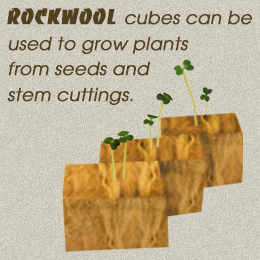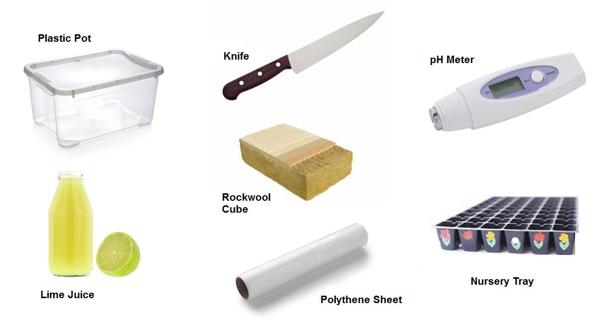Rockwool cubes have several advantages over soil when used for growing plants. Buzzle will tell you how to use rockwool cubes to germinate seeds and grow plants using cuttings.

Did You Know?Rockwool cubes make it difficult to over-water plants, since 18% of the cube is filled with air at any given time. Water can only fill the remaining volume.Rockwool is the name of a Danish company that produces stone wool. Stone wool, also called mineral wool, is a type of material made by melting basalt and spinning it in threads to create a structure that is then cut into cubes or slabs. This material was commonly used in the past as insulation for buildings due to its heat-resistant nature. It was also used for soundproofing purposes. Research on whether rockwool could be used for growing plants was carried out, and beginning in the 1960s, it began to be used for gardening in Denmark.
The advantages of rockwool is that the porous structure of the material ensures that the plant roots are in contact with moisture near the bottom and air in the upper region of the cubes. This is because, when the cubes are watered, the water is pulled lower by gravity. So, to compensate for this, air is pulled in the upper region, giving the plant a healthy environment of adequate moisture level along with sufficient aeration in the root zone. This is the reason why rockwool cubes should not be pressed too hard, as it may damage the structure, changing the properties of the material. Another advantage of rockwool is that, when the roots of the seedling emerge from the sides, it can be transplanted into larger cubes or slabs with great ease as compared to conventional transplantation in soil. Let us see the various ways rockwool cubes can be used for growing plants.Things Needed

◆ 1" rockwool cubes
◆ A pH test kit/pH meter
◆ Lime juice
◆ A plastic container/pot
◆ A polythene sheet
◆ Hydroponic nutrient solution bottle
◆ Nursery tray
◆ A humidome
◆ A heating mat
◆ A knife
◆ Rooting hormoneWarning
Wear a dust mask and gloves when handling rockwool. The fibers are harmful for the lungs, eyes, and skin.Germinating Seeds in Rockwool Cubes♧ Test the pH of the tap water using a pH meter or a pH test kit. Generally, it comes around 7 - 7.5. Acidify it using chemicals like lime juice and bring the pH to around 5.5. Do not go lower than 5, as it may damage the rockwool fibers.
♧ Saturate cubes of rockwool in it, by filling up water in a container and letting the cubes soak for 1 - 1½ hours.
♧ Prepare hydroponic nutrient solution (of pH 5.5) by following instructions given on the bottle. Hold the saturated cubes over the sink and pour the nutrient solution over it until it flows out from the bottom side of the cube. Using a nutrient solution is not always mandatory.
♧ Make a hole for the seeds if the cubes don't come with ready-made holes.
♧ Place the seeds in the hole by pressing the cube with the eraser end of a pencil. Insert more than one seed to increase the chances of getting a healthy seedling. Pull apart some rockwool at the top to cover the hole.
♧ Place the cube in a nursery tray and maintain the temperature at 70 to 85°F. You can partly cover the tray with a polythene sheet to create a warm environment.
♧ Water the cubes once every one or two days with the nutrient solution.
♧ Remove the polythene sheet when the seeds sprout.
♧ Select the strongest seedling (generally the tallest one) and snip off all the others near the base. Do not uproot them out of the cube.
♧ When the seedlings are around 2 - 4 inches tall, they can be transplanted.Cloning/Growing Plants Using Stem Cuttings♧ Prepare water of pH 5.5 to 6 from ordinary tap water.
♧ After rinsing, soak the rockwool cubes in it for 30 minutes to 1 hour.
♧ Take a 3 - 4" long cutting by making a diagonal cut below a node and trimming the leaves at the bottom. Leave two leaves at the top.
♧ Dip the bottom end of the cutting in a rooting hormone or powder.
♧ Place the cutting by inserting its bottom end in the hole present on the cube, ensuring that it does not emerge from the bottom of the cube.
♧ Place the cube in a tray and cover the tray with a humidome. Maintain the temperature between 70 to 90°F. Also use a heating mat.
♧ Regularly remove the dome and feel the cubes to see if they are dry. If yes, add nutrient solution.
♧ When the rooting starts, start opening the vents in the dome and close them after some time. Repeat this regularly for longer duration. Also, increase the size of the openings each time.
♧ After a few days, remove the dome and expose the plants to the outer environment. If the plants appear healthy after this, they are ready for transplanting.Transplanting the Saplings♧ First, fill potting mix in a pot, leaving out some space at the top. If transplanting outside, this is not applicable.
♧ Make a hole wide enough to accommodate the cube, but not equally deep.
♧ Place the cube in the depression. It should be at a higher level than the surrounding soil.
♧ Place some top soil around it to fit it well. The top soil layer should not be more than ¼" deep.
♧ Alternately, the plant can be transplanted on a rockwool slab as well. Using a knife, cut a square on the top of the slab, such that ¾ of the cube will sit in it. Place the cube over in the pit.
♧ Water the soil (not the cube) regularly, and after a few days the roots will penetrate the soil or the rockwool slab surrounding the cube.Thus, rockwool cubes can be used to grow plants from seeds and even from saplings. The only thing to remember here is not to over-water the cubes, as it will kill the plants.






 Did You Know?Rockwool cubes make it difficult to over-water plants, since 18% of the cube is filled with air at any given time. Water can only fill the remaining volume.Rockwool is the name of a Danish company that produces stone wool. Stone wool, also called mineral wool, is a type of material made by melting basalt and spinning it in threads to create a structure that is then cut into cubes or slabs. This material was commonly used in the past as insulation for buildings due to its heat-resistant nature. It was also used for soundproofing purposes. Research on whether rockwool could be used for growing plants was carried out, and beginning in the 1960s, it began to be used for gardening in Denmark.
Did You Know?Rockwool cubes make it difficult to over-water plants, since 18% of the cube is filled with air at any given time. Water can only fill the remaining volume.Rockwool is the name of a Danish company that produces stone wool. Stone wool, also called mineral wool, is a type of material made by melting basalt and spinning it in threads to create a structure that is then cut into cubes or slabs. This material was commonly used in the past as insulation for buildings due to its heat-resistant nature. It was also used for soundproofing purposes. Research on whether rockwool could be used for growing plants was carried out, and beginning in the 1960s, it began to be used for gardening in Denmark. ◆ 1" rockwool cubes
◆ 1" rockwool cubes